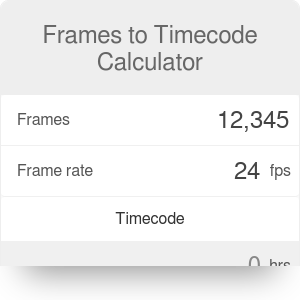

With Ripple Forward off, changing the TC In or TC Out will affect only the item being edited.The Ripple Forward mode is useful if a change in the program has caused elements to shift (e.g., a shot being added or removed) and you must consequently revise the timecode of everything following. With Preserve Duration on, changing the TC In will cause a corresponding change to the TC Out (and vice versa) such that the item's duration remains the same.įor example, changing an item's TC In from 01:00:00:00 to 01:00:15:00 would also add 15 seconds to its TC Out.With Preserve Duration off, changes to the TC In or TC Out are discrete and will cause the item's duration to be recalculated accordingly.
#Timecode calculator converter update#
The Preserve Duration mode is useful if an element has moved on the timeline and you'd like to update both its TC In and TC Out in one step. These modes-Preserve Duration and Ripple Forward-can be toggled by buttons immediately above the notes list (or iva Edit > Timecode > Preserve Duration and Ripple Forward). When you modify an item's timecode (by changing either its TC In, TC Out or Duration), two editing modes can cause additional side effects based on your change. You can also quickly enter :00 by just typing a period. When entering timecode you do not have to type the colons. Duration is calculated automatically (changing it will adjust the TC Out accordingly).

Src TC In/Out Timecode "in" and "out" corresponding to the source material.Īll fields, except for Pgm TC In/Out, are optional. Source An additional label to name the source material for a shot or element (e.g., stock footage tape), if applicable.
#Timecode calculator converter free#
Description Free text for the contents of this note. Name Another keyword specifying this item (e.g., character name for ADR, shot name for VFX, music cue name). Kind A keyword describing the nature of this item (e.g., "ADR", "VFX", "Stock", "Music"). Duration The item's duration (extending from its TC In to TC Out). Pgm TC In/Out The "in" and "out" program timecode for the item. The editor's notes table, in the main part of the window, displays several columns: To delete existing notes, select them and then click (or use Edit > Delete). If your program is in a time base other than 23.98 NDF, select the appropriate time base from the Native Format: pop-up menu.Īdd a new note to the document by clicking (or Edit > New Note from the menu). Your editor's notes can be built by hand or populated from an existing Final Cut project, then exported as a text file or brought into Excel.Ĭhoose File > New Editor’s Notes to create a new document. It eases the management of assets and clips in a film or video project for the purposes of creating ADR or VFX lists, stock footage or music cue sheets, and notes for the online editor or colourist. Before this moment millions of applications will need to either adopt a new convention for time stamps or be migrated to 64-bit systems which will buy the time stamp a "bit" more time.An Editor's Notes document is like a spreadsheet specifically tailored for the needs of an editor or assistant editor. On this date the Unix Time Stamp will cease to work due to a 32-bit overflow. This is very useful to computer systems for tracking and sorting dated information in dynamic and distributed applications both online and client side. It should also be pointed out (thanks to the comments from visitors to this site) that this point in time technically does not change no matter where you are located on the globe. Therefore, the unix time stamp is merely the number of seconds between a particular date and the Unix Epoch. This count starts at the Unix Epoch on January 1st, 1970 at UTC. The unix time stamp is a way to track time as a running total of seconds.


 0 kommentar(er)
0 kommentar(er)
